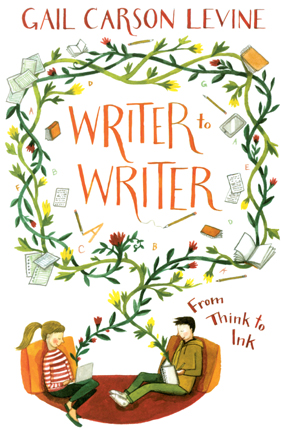| Writer to writer : from think to ink Author: Levine, Gail Carson | ||
| Price: $6.50 | ||
Summary:
A bestselling author shares her secrets of great writing in a companion to Writing Magic.
| Accelerated Reader Information: Interest Level: MG Reading Level: 6.50 Points: 9.0 Quiz: 171103 |
Reviews:
Kirkus Reviews (10/15/14)
School Library Journal (+) (11/01/14)
Booklist (11/01/14)
The Bulletin of the Center for Children's Books (02/15)
Full Text Reviews:
Booklist - 11/01/2014 Popular author Levine offers copious writing advice in this companion to her earlier work on the subject, Writing Magic: Creating Stories That Fly (2006), using questions from her eponymous blog as a framework. Here, she offers general guidance, such as establishing good writing habits and finding a reader you trust, as well as specific direction for everything from building character to choosing and managing tense, drawing on examples of excellence from everyone from M. T. Anderson to Langston Hughes. Individual chapters on different elements of story offer practical suggestions—the chapter on building tension features no fewer than 10 useful tools—and conclude with a variety of writing prompts and a refrain to “have fun, and save what you write!” As the title suggests, Levine writes for a practiced audience; exercises often involve the revision of existing work, rewriting a story in verse, or in another tense, and a beginner might feel overwhelmed. Still, avid writers will find meaningful guidance, support, and inspiration in Levine’s polished, enthusiastic instruction. - Copyright 2014 Booklist.
School Library Journal - 11/01/2014 Gr 5–8—In this follow-up book to Writing Magic Creating Stories That Fly (HarperCollins, 2006), fantasy author Levine doles out realistic and helpful guidance to aspiring authors. This title is an extension of her blog, and Levine provides her audience with the common nuts and bolts of the profession, offering this advice: writers write, they keep writing, and they save everything they write to use again. Levine's tone is conversational and upbeat and her suggestions easy to follow, tinged with an underlying sense of encouragement that will bolster readers. She discusses common difficulties, warning young people not to get hung up on minutiae and letting them know that confronting challenges is a surmountable part of the craft. The chapters are based on questions that have been posted to her blog and address how to develop characters and backstory, come up with plot twists and flashbacks, and create mystery and tension. Each chapter ends with appealing and doable exercises. Levine urges her audience to cast away self-criticism and to write and rewrite, underscoring that this is an enjoyable, important process. An engaging and valuable addition.—Patricia Feriano, Montgomery County Public Schools, MD - Copyright 2014 Publishers Weekly, Library Journal and/or School Library Journal used with permission.
Bulletin for the Center... - 02/01/2015 In 2009, Gail Carson Levine began a blog that became a writer’s advice column in response to her readership. This book represents a best-of collection of the entries in that blog, but the posts have been expanded, shaped, and collected into coherent topics ranging from the many ways a writer might schedule her writing time, to places to get ideas, to developing character, plot, and other aspects of story, to tips on achieving clarity in your prose. In addition to these post gleanings, Levine has added chapters on poetry writing and on blogging itself. As with her previous writer’s advice book, Writing Magic (BCCB 1/07), each chapter ends with a set of prompts for practicing the principles discussed in the chapter, along with her two rules, “Have fun, and save what you write!” In this title, however, she quotes directly from people who have posted questions to the blog as her impetus for each chapter’s subject matter, and while the book may be entered at any chapter, the prompts themselves often build cumulatively on the story snippets she uses to inspire and illustrate her points. The snippets themselves are marvelously diverse, opening the possibilities for writing in a multitude of genres. By the end of the book, if a reader has faithfully followed her instruction, he or she will be well on the way to becoming a writer. KC - Copyright 2015 The Board of Trustees of the University of Illinois.



